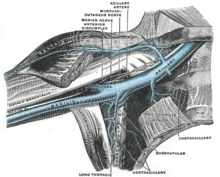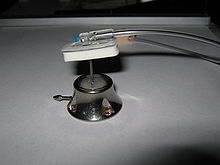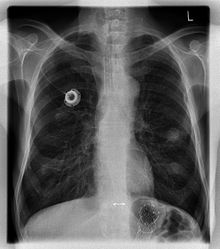- Port (medical)
-
In medicine, a port (or portacath) is a small medical appliance that is installed beneath the skin. A catheter connects the port to a vein. Under the skin, the port has a septum through which drugs can be injected and blood samples can be drawn many times, usually with less discomfort for the patient than a more typical "needle stick".
Ports are used mostly to treat hematology and oncology patients, but recently ports have been adapted also for hemodialysis patients.
The port is usually inserted in the upper chest, just below the clavicle or collar bone, leaving the patient's hands free.
Contents
Terminology
The term portacath is a portmanteau of "portal" and "catheter". Port-a-Cath is a brand name of Smiths Medical; others include Microport, Bardport, PowerPort (power injectable), Passport, Infuse-a-Port, Medi-Port, and Lifesite (for hemodialysis patients). The term totally implantable venous access system (TIVAS) is also used. Additionally, a portacath is the main form of a central venous access device, and is frequently referred to as such in the medical field.
How it works
 The catheter runs from the portal and is surgically inserted into a vein (usually the jugular vein, subclavian vein, or superior vena cava). Ideally, the catheter terminates in the superior vena cava, just upstream of the right atrium. This position allows infused agents to be spread throughout the body quickly and efficiently.
The catheter runs from the portal and is surgically inserted into a vein (usually the jugular vein, subclavian vein, or superior vena cava). Ideally, the catheter terminates in the superior vena cava, just upstream of the right atrium. This position allows infused agents to be spread throughout the body quickly and efficiently.
A port consists of a reservoir compartment (the portal) that has a silicone bubble for needle insertion (the septum), with an attached plastic tube (the catheter). The device is surgically inserted under the skin in the upper chest or in the arm and appears as a bump under the skin. It requires no special maintenance and is completely internal so swimming and bathing are not a problem. The catheter runs from the portal and is surgically inserted into a vein (usually the jugular vein, subclavian vein, or superior vena cava). Ideally, the catheter terminates in the superior vena cava, just upstream of the right atrium. This position allows infused agents to be spread throughout the body quickly and efficiently.
The septum is made of a special self-sealing silicone rubber; it can be punctured hundreds of times before it weakens significantly. To administer treatment or to withdraw blood, a health professional will first locate the port and disinfect the area. Then he or she will access the port by puncturing the overlying skin with a 90° Huber point needle although a winged needle may also be used. (Due to its design, there is a very low infection risk, as the breach of skin integrity is never larger than the caliber of the needle. This gives it an advantage over indwelling lines such as the Hickman line.) Negative pressure is created to withdraw blood into the vacuumized needle, to check for blood return and see if the port is functioning normally. Next, the port will be flushed with a saline solution. Then, treatment will begin. After each use, a heparin lock is made by injecting a small amount of heparinized saline (an anticoagulant) into the device. This prevents development of clots within the port or catheter. In some catheter designs where there is a self-sealing valve at the far end, the system is locked with just saline. The port can be left accessed for as long as required. The port is covered in a dressing to protect the site from infection and to secure the needle in position.
If a port is used infrequently, it may be necessary to access the port, flush it with saline, and inject a new heparin lock every month to prevent clotting between uses.
The surgery itself is considered minor, and is typically performed under both local anaesthesia and conscious sedation. Patients sometimes have a little discomfort after the procedure, and can be managed with a narcotic, such as demerol for 24–48 hours.
A port is most commonly inserted as a day surgery procedure in a hospital or clinic by a surgeon or an interventional radiologist, under conscious sedation. When no longer needed, the port can be removed in the operating room.
Uses
Ports have many uses:
- To deliver total parenteral nutrition in those unable to take (adequate) food orally for a long period of time.
- To deliver chemotherapy to cancer patients who must undergo treatment frequently. Chemotherapy is often toxic, and can damage skin and muscle tissue, and therefore should not be delivered through these tissues. Portacaths provide a solution, delivering drugs quickly and efficiently through the entire body via the circulatory system.
- To deliver coagulation factors in patients with severe hemophilia.
- To withdraw (and/or return) blood to the body in patients who require frequent blood tests, and in hemodialysis patients.
- To deliver antibiotics to patients requiring them for a long time or frequently, such as those with cystic fibrosis and bronchiectasis.
- Delivering medications to patients with immune disorders.
- For treating alpha 1-antitrypsin deficiency with replacement therapy
- For delivering radiopaque contrast agents, which enhance contrast in CT imaging.
- To fill or withdraw fluid from the Lap-Band or Realize gastric bands used in Bariatric surgeries.
Variations
There are many different types of portacaths. The particular type selected is based on the patient's specific medical conditions.
Portals:
- can be made of plastic, stainless steel, or titanium
- can be single chamber or dual chamber
- vary in height (although the base is about the size of a quarter)
Catheters:
- can be made of biocompatible, medical-grade polyurethane or silicone
- can vary in length (cm)
- can vary in diameter (mm)
Portacaths can be put in the upper chest or arm. The exact positioning itself is variable as it can be inserted to avoid visibility when wearing low cut shirts, and to avoid excess contact due to a backpack or bra strap. The most common placement is on the upper right portion of the chest, with the catheter itself looping through the right subclavian vein down towards the patient's heart. It can also be situated on the muscle that sits on the ribs with the tube coming up towards the heart.
Risks
- Infection - a severe bacterial infection can compromise the device, require its surgical removal, and seriously jeopardize the health of the already weak patient.
- Thrombosis - formation of a blood clot in the catheter may block the device irrevocably. To prevent clotting the portacath is flushed with saline and heparin, usually by a nurse or other medical professional, or someone properly trained that is a family member or the patient, at least once every four weeks, or more often in conjunction with administering medication.
- Mechanical failure - is extremely unlikely. It is possible in a rare event that part of the system could break, usually the attached catheter, and become lodged in the circulatory system. In such a case it is unlikely to cause serious harm; many patients are asymptomatic but the mechanical failure is discovered because of an inability to flush or withdraw fluids from the port. In those rare instances intervention surgery is required to withdraw the failed vascular access device.
- Age - If the device is put into a child, the child's growth means that the catheter becomes relatively shorter and will move away from the inferior part of the superior vena cava - it might be necessary to remove or replace it.
- Pneumothorax - Attempts to gain access to the subclavian vein or jugular vein can injure the lung, possibly leading to this complication. If the pneumothorax is large enough, a chest tube might need to be placed. In experienced hands, the incidence of this complication is about 1%.
- Arterial injury - The subclavian artery can be inadvertently punctured. This usually leads to a subcutaneous hematoma and occasionally a pseudoaneurysm. An alternative site may need to be used for port placement. Puncture of the carotid artery is more rare, since attempts to access the nearby jugular vein are increasingly done with ultrasound guidance.
Manufacturers
The major manufacturers of ports are Bard Access Systems, Navilyst Medical, Smiths Medical, MedComp, Rita Medical Systems and AngioDynamics.
See also
- Peripherally inserted central catheter or "PICC"
- Central venous catheter or "central line"
External links
- Bard Access Systems' Implantable Ports
- Smiths Medical Implantable Ports
- Portacath Catheter Information
Patient information
Categories:- Medical equipment
- Oncology
- Catheters
- Implants
Wikimedia Foundation. 2010.


